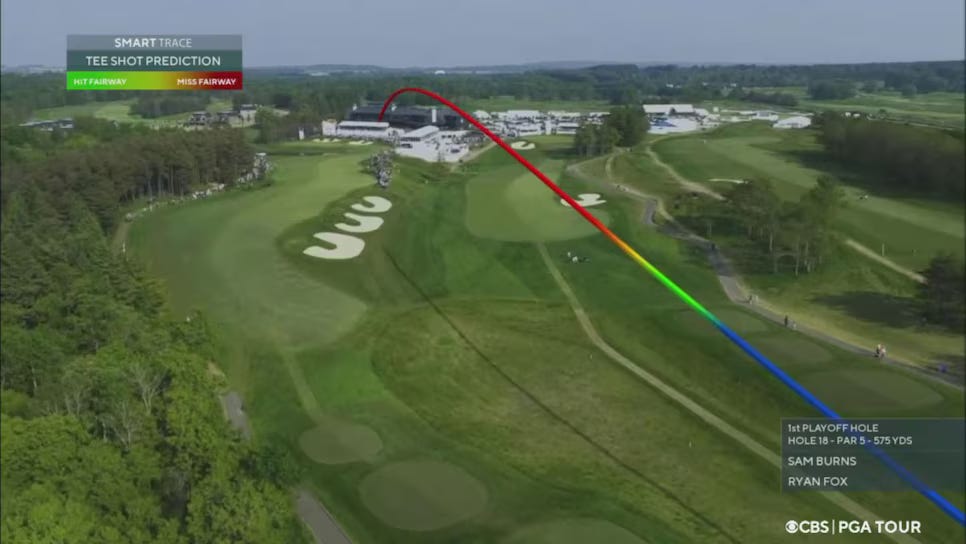Golf’s Spoiler Alert: Will Predictive Shot Tracing Kill the Drama or Redefine It?
As the PGA Tour rolls out smart-trace tech powered by drone AR and predictive analytics, fans are split, is this innovation enhancing golf’s story or fast-forwarding through its suspense?
Somewhere between the crack of the driver and the ball’s soft thud on turf lies golf’s purest form of tension, that window of uncertainty. A moment where anything can happen, and now, it’s under threat. At least that’s what some fans believe.
When Shane Lowry stepped up to the tee at TPC Toronto, he became the first test subject in what might be the PGA Tour’s most divisive broadcast innovation yet. A sleek new overlay appeared onscreen, colour-coded, predictive, and driven by years of investment in drone AR, cloud computing, and advanced shot-tracking infrastructure. The ball flight traced in blue. Then, a 1.2 second pause. The line turned green. The shot was good. The suspense? Decided before the ball had even landed.
This is the new “smart tracing” feature, born out of the PGA Tour’s partnership with NBC, CBS, and a trio of production tech firms. It merges real-time drone footage with predictive analytics to pre-emptively colour a golfer’s tracer: green for safe, red for trouble. Simple enough on paper. But on TV, it changes everything.
The Tour calls it progress. Many fans call it a spoiler.
It’s clever, but whether it’s good TV is still up for debate.
Follow me for more sports and life updates: Instagram
Broadcast tech in golf has always walked a tightrope. Shot tracers were once controversial, as well, with purists grumbling that they took away the mystery of ball flight. Now, they’re as standard as a leaderboard. Smart tracing, though, takes it a step further. It moves the moment of tension. You no longer hold your breath when the ball lands near a bunker; you watch the line turn red and brace for the inevitable.
For some, that shift feels surgical and emotionless. Like watching poker with every card already face-up. But here’s the rub: sport isn’t just about what happens. It’s about how you experience it.
That’s the case Turnbull and Freedman—the PGA Tour’s senior tech leaders—make in defence of the innovation. For them, it’s not about robbing drama but reshaping it. “This is just real-time feedback,” Turnbull says. “It’s becoming part of the story.”
Modern fans aren’t strangers to context. But golf’s relationship with suspense is delicate. The sport thrives in those few seconds between the strike and the ball settling. Unlike football or basketball, where drama comes thick and fast, golf relies on taking a longer moment of anticipation.
Do fans trust that these tools serve the experience, rather than hijack it?
Predicta-ball, an earlier PGA Tour experiment that predicted shot outcomes on par 3s, quietly vanished from broadcasts. The tech may live on in some form, but its short run suggests one thing: even clever tools can outsmart themselves.
Smart tracing is a different beast. It’s impressive tech that feeds off data that gets sharper as the round progresses, learning from ground conditions and rollouts in real time. Yet there’s a lingering sense that the Tour is solving a problem that nobody asked to be fixed.
Sport, at its best, isn’t perfect. It’s messy, unpredictable, and sometimes cruel. That’s what makes it magnetic. And there’s a difference between enhancing the story and skipping to the end.
The smart tracing debate isn’t just about tech. It’s about attention. In a world where everything is being optimised, like your feeds, your viewership, and your dopamine levels, there’s something sacred in letting drama play out in real time. Especially in a sport like golf, where so much of the spectacle lives in the pause.
As one Golf Digest editor said, “You wouldn’t want a graphic telling you if a Steph Curry shot was going in as it left his hand.” And yet, here we are.
Smart tracing is the latest line in golf’s digital sand. It’s clever, but whether it becomes part of the fabric or just another flashy experiment depends on how it evolves, and how we, as viewers, respond.
Because sometimes, the best stories are the ones we don’t see coming.
Thanks for reading, David Skilling.
For more like this, check out the archive.
If you hit the like button, you’ll be doing me a huge favour. If your business needs sports writing, wants to discuss advertising, or you have PR stories to pitch, feel free to get in contact.
If you know someone who will enjoy this article, please share it with them.


